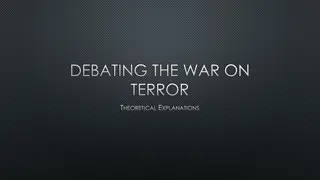Social Security Disability Claims Process Overview
The process of applying for Social Security Disability (SSD) benefits involves obtaining forms, submitting documentation, and potentially going through appeals if denied. Claimants can request reconsideration and hearings before an Administrative Law Judge (ALJ). The volume of claims each year is significant and impacts cases like Mathews v. Eldridge, where benefit termination without a hearing was an issue. Differences between SSI determinations and welfare determinations, as seen in the Goldberg case, highlight the importance of evidence and witness testimony in disability determinations, affecting the equities of cases and the decision-making process.
Download Presentation

Please find below an Image/Link to download the presentation.
The content on the website is provided AS IS for your information and personal use only. It may not be sold, licensed, or shared on other websites without obtaining consent from the author.If you encounter any issues during the download, it is possible that the publisher has removed the file from their server.
You are allowed to download the files provided on this website for personal or commercial use, subject to the condition that they are used lawfully. All files are the property of their respective owners.
The content on the website is provided AS IS for your information and personal use only. It may not be sold, licensed, or shared on other websites without obtaining consent from the author.
E N D
Presentation Transcript
Mathews v Eldridge (1976) From Social Security to Targeted Killings 1
Social Security Disability Basic Procedure Get a form the Social Security office What is the illness, the work history, the doc? SSI orders records A doc at SSI at Disability Determination Service - run by state as contractor - makes a determination Sends to regional office Regional office approves the claim, ask for more info, or denies the claim. Claimant can ask for reconsideration This is all done with records 2
Social Security Disability Basic Procedure - Appeals Most problems arise because of poor documentation The agency has limited authority to reject the treating physician's evaluation. After denial, you can ask for a hearing before an ALJ 80% or more of all the federal ALJs The agency treats the ALJ's decision as final At this point you can appeal to the agency internal appeals process, then to the federal courts Positive decisions are retroactive - critical DP point Generates the money to pay the attorney as well 3
Volume of Claims Are there a lot of Social Security Disability claims every year? Why is this important background for Matthews v. Eldridge? Think about what this process looks like from the perspective of a disabled person tying to get benefits, or trying to avoid having benefits cancelled. Will they usually have benefit of counsel? 4
Background of the Case Claimant had qualified for SSD in the past and was getting benefits. SSD does routine reevaluations to see if claimants are still eligible. If the claimant does not provide evidence of continuing disability, or if the agency does not accept the evidence, benefits are terminated without a hearing. Claimant can then request a hearing, and if successful, the benefits are retroactive. 5
How are SSI Determinations Different from Welfare Determinations What sort of information was at issue in Goldberg? What data is used for making disability determinations? Who would be the witnesses and how is their information collected? Is this different from the witnesses in Goldberg? How is the value of the claimant's testimony different from that in Goldberg? How does this change the equities of Goldberg? Why is the administrative decisionmaker less prone to make errors in this case than in Goldberg? 6
The Mathews Factors First, the cost of an erroneous deprivation of the private interest at issue - (V) Second, the probability of reducing the chance of error through more extensive or different procedures - (P) Third, the government's interest in its procedures, i.e., the incremental cost of the additional or different procedures that might reduce errors - (C) Look familiar? 7
The Hand Formula B = PL (P) the probability that an accident will occur (L) the magnitude of the resulting harm, if any accident occurs (B) the cost of precautions that would reduce the expected harm United States v. Carroll Towing Co., 159 F.2d 169 (2d Cir. 1947) 8
The Mathews Factors as a Cost Benefit Analysis What is the relationship between C and (P x V) (C)ost of added process (P)robability of increased accuracy (V)alue of the benefit/cost of error. C < P x V What is the key to convincing the court that your client should get more process? How does this transform the notion of fairness? Is due process a good on its own in this analysis? 9
Apply these Factors to the Case How would you apply these factors to the Matthews case? Does plaintiff get his pre-termination hearing? What about detaining a tuberculosis carrier? A terrorist who might have information about a pending attack? 10
Matthews as a the End of the Warren Court How is Matthews different from the ideal of due process in Goldberg? How does it differ from the notion that every person for every crimes gets the same criminal due process rights, including counsel? Would we do better in criminal law if we were forced to recognize costs and benefits? Could the LA public defender system meet the Matthews test? 11
How Far Does Matthews Go? Hamdi v. Rumsfeld, 124 S.Ct. 2633 (2004) The ordinary mechanism that we use for balancing such serious competing interests, and for determining the procedures that are necessary to ensure that a citizen is not "deprived of life, liberty, or property, without due process of law," U. S. Const., Amdt. 5, is the test that we articulated in Mathews v. Eldridge. Mathews dictates that the process due in any given instance is determined by weighing "the private interest that will be affected by the official action" against the Government's asserted interest, "including the function involved" and the burdens the Government would face in providing greater process. The Mathews calculus then contemplates a judicious balancing of these concerns, through an analysis of "the risk of an erroneous deprivation" of the private interest if the process were reduced and the "probable value, if any, of additional or substitute safeguards. http://biotech.law.lsu.edu/cases/nat-sec/hamdi.htm (at 65) 12























